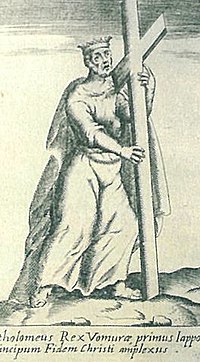Ōmura Sumitada
Ōmura Sumitada ( Japanese 大村 純 忠 ; * 1533 ; † June 23, 1587 ) was a Japanese Christian Sengoku daimyo who ruled over the province of Hizen (now Nagasaki Prefecture ).
Life
In 1474 the neighboring Arima Ōmura Sumiyoshi inflicted a defeat and subsequently exercised considerable influence on the Ōmura. In the following century, Ōmura Sumisaki adopted a son of Arima Haruzumi , an event that caused the affected adoptive son, Sumitada , many difficulties in his own rule. Haruzumi's other son, Takaaki , was disinherited as a result of this adoption, and after he eventually entered the Goto clan , he was extremely hostile to his previous family. In fact, Sumitada had to contend with the anger of some local princes, all of whom were related to him in various ways, including Saigo Sumitaka (his brother-in-law). In addition, the Matsuura and Arima crowded the borders of the Ōmura. However, Ryūzōji Takanobu , the most powerful daimyō in Hizen Province , was still the greatest threat.
Faced with the seemingly inevitable fall of the Ōmura, Sumitada turned to the only party that seemed capable of supporting him - the Jesuits . In 1562 he allowed Christian priests to preach in his country and gave Portuguese traders special privileges in the port of Yokoseura . In June of the following year, Sumitada became the first Christian daimyō, baptized in the name of Dom Bartolomeu . Sumitada's religious and political machinations did no good. The same year he was baptized, Goto Takaaki rebelled, and Yokoseura was destroyed in the battle that followed. The event seemed to herald the fall of the Ōmura, in 1566 Sumitada was forced to flee from Aonogi-jō - his headquarters. But now the Portuguese had returned and with the weapons they provided him, Sumitada was able to retake Sonogi and strengthen his position. Ōmura managed to fend off its numerous rivals for the next two decades and Portuguese ships continued to call at Ōmura ports. The pact with the Jesuits was more or less a blessing for Sumitada, although it provoked hostile families. In 1572, Saigo Sumitaka led a coalition of the enemies of the Ōmura, a threat that Sumitada countered in 1574 with the help of four Portuguese warships. In the 1570s there was a turning point in the mission to Japan. Sumitada, with whom many samurai had also been baptized, forced his subordinates, including the Buddhist monks, to attend the Christian instruction, and so there were mass conversions and expulsions. From the Portuguese standpoint, Sumitada's conversion was an encouraging development, but by and large not fruitful - until 1580 at least. In that year Ryūzōji Takanobu became the most powerful daimyō in the north of Kyūshū and his forays into Sonogi forced generous donations from Sumitada to the Jesuits. On June 9th, he ceded judicial authority over the port of Nagasaki to the Jesuits.
This dramatic move followed two invasions by the Ryūzōji (1577 and 1578) and was less intended to ensure the survival of the Ōmura than to secure the Christian presence in the province of Hizen. Beyond all sorts of pious motivations, Sumitada gained much from continuing trade with the Portuguese, especially when this meant an end to the war with the Ryūzōji. Since Takanobu would drive out the foreigners, should the Ōmura submit, Sumitada officially “gave” Nagasaki to the Jesuits, but retained the right to collect customs duties. Later that year, Ōmura went to Saga and submitted to the Ryūzōji. Takanobu was reluctant to confront the Portuguese directly, as the power of these "southern barbarians" was still something of an unknown element. Just as Sumitada had hoped, Takanobu let Nagasaki stay. The Jesuits were able to report an unexpected upswing in astonished Rome .
The Ōmura were now vassals of the Ryūzōji. Takanobu's eye fell on the Arima on the Shimabara peninsula , which, like the Ōmura, had asked foreigners for help. In 1584, Shimazu Yoshihisa sent an expeditionary force to aid the Arima, prompting Takanobu to personally lead an army to Shimabara.
Sumitada was supposed to lead his men in support, but left too late and missed the decisive battle of Okitanawate . Takanobu was killed in this battle and the political picture in Hizen changed drastically.
In 1587 Toyotomi Hideyoshi invaded Kyūshū and the Ōmura submitted to him, although they had lost Nagasaki. Sumitada died in the same year, his successor was Ōmura Yoshiaki (1568-1615).
| personal data | |
|---|---|
| SURNAME | Ōmura Sumitada |
| ALTERNATIVE NAMES | 大村 純 忠 (Japanese); Arima Sumitada (maiden name); 有 馬純忠 (Japanese, maiden name); Dom Bartolomeu (baptismal name) |
| BRIEF DESCRIPTION | Japanese Christian daimyo |
| DATE OF BIRTH | 1533 |
| DATE OF DEATH | June 23, 1587 |
